

In the world of land management, efficiency and adaptability are more important than ever. Compact mulching solutions using specialized attachments designed for mini excavators are playing an increasingly vital role, particularly on Australia’s varied landscapes. These systems allow operators to transform smaller-scale machinery into powerful vegetation and debris processors, tackling tasks once reserved for much larger, less nimble equipment.
What sets these solutions apart is their seamless integration: compact mulcher attachments slot directly onto existing mini excavators. They create a flexible setup for clearing bushland, managing regrowth, and maintaining firebreaks – all tasks crucial across urban, agricultural, and remote outback environments. With demands for responsible land care and efficient project delivery on the rise, this equipment is making a distinct impact in Australia’s market.
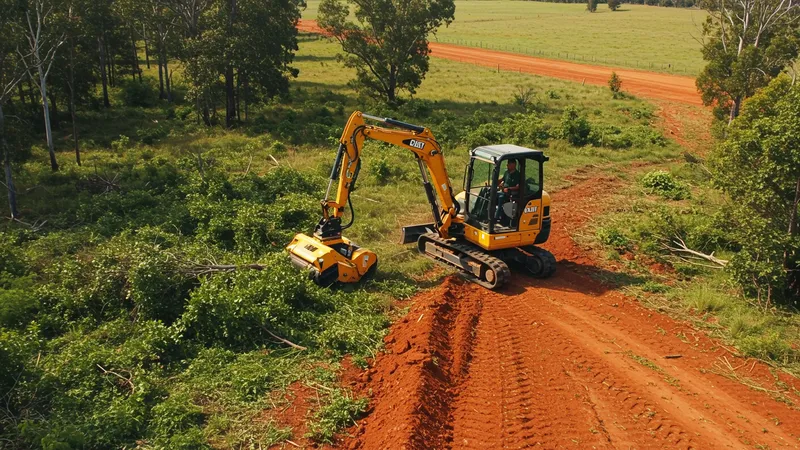
Compact mulchers for mini excavators offer substantial benefits for Australian landowners and contractors alike. Compared to large dedicated mulching machines, these attachments eliminate the need for major fleet investments while still delivering reliable performance. The quick-mount design ensures that a single mini excavator can be refitted within minutes, switching from digging to mulching and back again without delays or idle time.
One noteworthy advantage is adaptability: Australian terrain ranges from open farmland to dense scrub and rocky slopes. The featured attachments, such as the Fecon CEM36 and FAE BL1/EX, are engineered for these challenges. Operators gain access to remote sites, creek lines, and steep embankments, maximizing land use while minimizing the impact on delicate environments.
Regulations around fire safety and vegetation management are strict in Australia, particularly in regions prone to bushfires. Mulcher attachments help meet local council and state compliance for fuel reduction, native regeneration, and ecological conservation work. For contractors bidding on government or infrastructure projects, the capability to efficiently mulch and process organic material makes these tools highly practical.
Cost-efficiency is another crucial insight. By repurposing existing mini excavators rather than expanding heavy equipment fleets, Australian businesses can keep capital expenditure in check. This model not only reduces maintenance and transport costs but also makes advanced land care strategies accessible to smaller operators and regional councils striving to stay competitive.
For those seeking broader context and performance comparisons, the coming pages delve deeper into attachment features, application tips, and real-world Australian case studies. The deeper details reveal even more valuable insights ahead…
Understanding the standout features of mulching attachments is essential for Australian mini excavator owners. The Fecon CEM36 and FAE BL1/EX lead the field with heavy-duty rotor systems, allowing operators to process native hardwoods and dense regrowth efficiently. These attachments incorporate replaceable, heat-treated teeth for longevity and consistent cutting power. Hydraulically driven with variable torque, they adapt in real time to changing vegetation densities across Australia’s diverse regions.
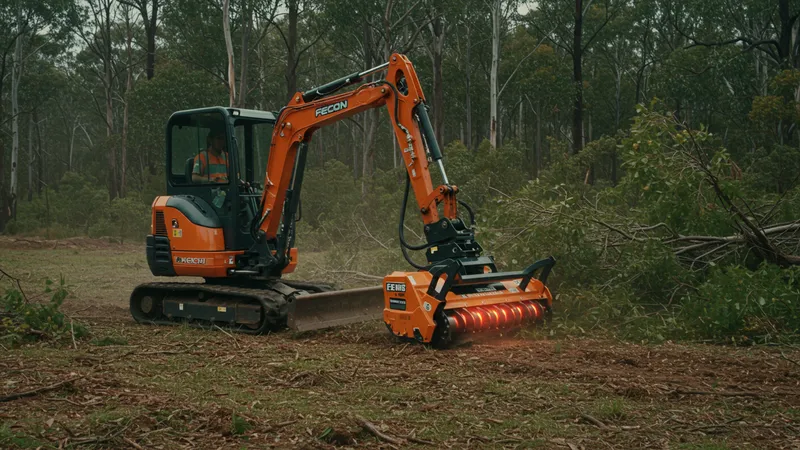
Attachment compatibility is a chief consideration. Brands like Fecon and Mower King produce mounting plates and hydraulic adapters that fit multiple mini excavator makes, including Kubota, Hitachi, and Takeuchi, prominent across the Australian market. This flexibility means contractors can maximize the use of existing gear and reduce downtime during mulcher swaps, especially when working on projects that blend earthmoving and vegetation management.
Safety features are another vital component in the Australian context. Attachments frequently include heavy-duty debris guards, pressure relief valves, and emergency hydraulic shut-off systems, providing extra protection in unpredictable bush environments. Robust casing and thoughtful engineering minimize flying debris, helping to secure both operators and nearby personnel. These attributes are increasingly important as worksite safety regulations tighten nationwide.
Additionally, maintenance requirements for these solutions tend to be straightforward, a crucial advantage in remote or regional Australian settings. Replaceable teeth and accessible lubrication points allow for rapid daily upkeep. This minimizes schedule disruptions and ensures that contractors can deliver on tight timelines, even in the unpredictable climates of Queensland, New South Wales, or Western Australia.
Compact mulcher attachments have revolutionized the way Australians manage land. In peri-urban areas ringing major cities like Melbourne and Sydney, contractors utilize these tools to control rapid regrowth along utility easements and fence lines. Their maneuverability allows for detailed work along driveway verges and property boundaries – zones that are inaccessible to larger machinery yet critical for aesthetic and safety reasons.
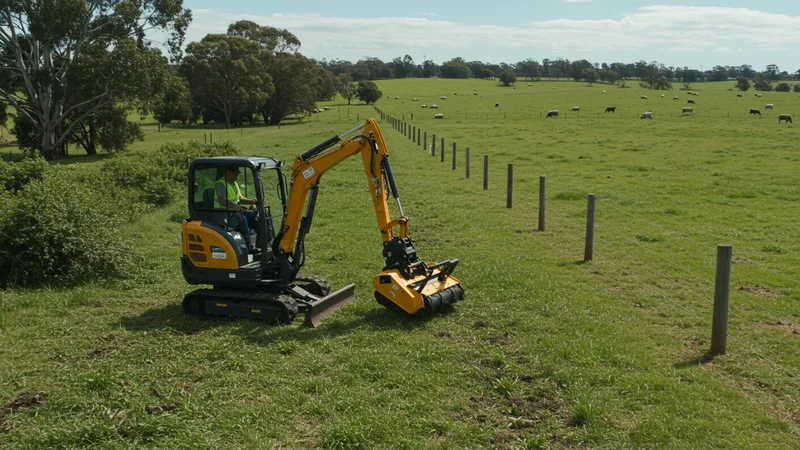
Rural and agricultural landowners in Australia increasingly deploy mini excavator mulchers for weed management, woody weed reduction, and paddock maintenance. With native bush encroachment threatening grazing areas, attachments like the FAE BL1/EX cut through lantana, blackberry, and bracken fern, boosting pasture productivity while avoiding chemical controls. This practical approach keeps livestock safe and reduces manual labor requirements.
Firebreak creation is another indispensable use case. Across fire-prone regions such as Victoria’s Yarra Ranges or South Australia’s Adelaide Hills, rapid deployment of mulchers helps maintain fuel-reduced corridors and access tracks. Attachments’ compact dimensions allow for precision clearing under powerlines and around structures, which is essential for meeting local bushfire compliance schedules.
In infrastructure and civil works, contractors across Australia are required to clear and rehabilitate land before, during, and after project delivery. Instead of sourcing dedicated forestry machines, project managers use mini excavator mulchers to clear invasive species, shred debris, and blend mulched material back into topsoil. Adaptive performance across terrains reduces project costs for both public sector agencies and private developers.
Performance benchmarks help Australian contractors differentiate between the Fecon CEM36, FAE BL1/EX, and Mower King EM60. The Fecon CEM36 stands out for its dual hydraulic motor system, providing high torque and rapid spool-up even in banksia or eucalyptus-laden zones. Users frequently note its ability to produce fine mulch, which decomposes quickly and aids native seedling growth in restoration projects.
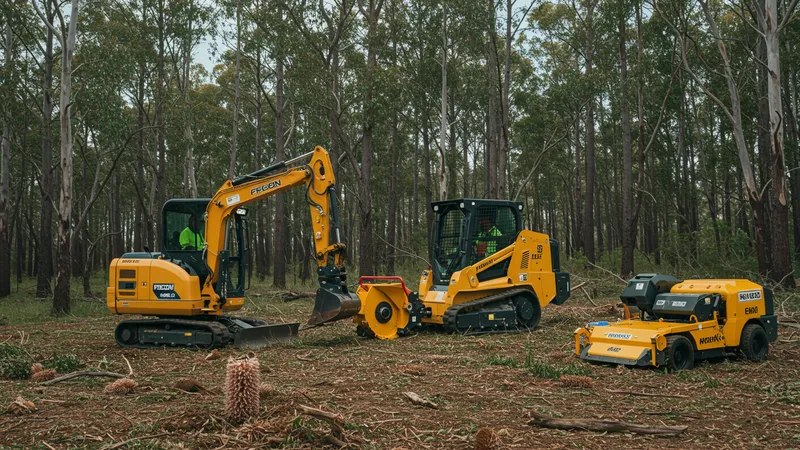
The FAE BL1/EX, meanwhile, is distinguished by its compact profile and lighter weight. These factors are crucial when mounting on smaller mini excavators (as low as 4 tonnes) popular on residential or steep terrain projects. Its fixed-tooth rotor design is well-regarded for consistent chipping action and lower power draw, providing fuel savings on long Australian summer days.
Mower King’s EM60 appeals to contractors with volume-driven projects. It boasts a wider cutting swath and is known for consumer-friendly servicing, with parts readily available in major Australian cities. The robust bearings and streamlined drive system suit repetitive workloads such as council verge maintenance or orchard understory clearing, where uptime is critical.
Local Australian support infrastructure further elevates these brands. Both Fecon and FAE maintain dealership networks and parts hubs across Queensland, Victoria, and Western Australia. This ready access to technical advice can be the difference between meeting and missing project deadlines on vast outback or regional jobs.
Choosing the right mulcher attachment for a mini excavator in Australia involves evaluating the intended terrain, vegetation type, and operational hours. For contractors working in sensitive native areas, attachments with low ground pressure and fine-mulching capacity, such as the Fecon CEM36, can prevent soil compaction while producing uniform mulch ideal for regeneration projects.
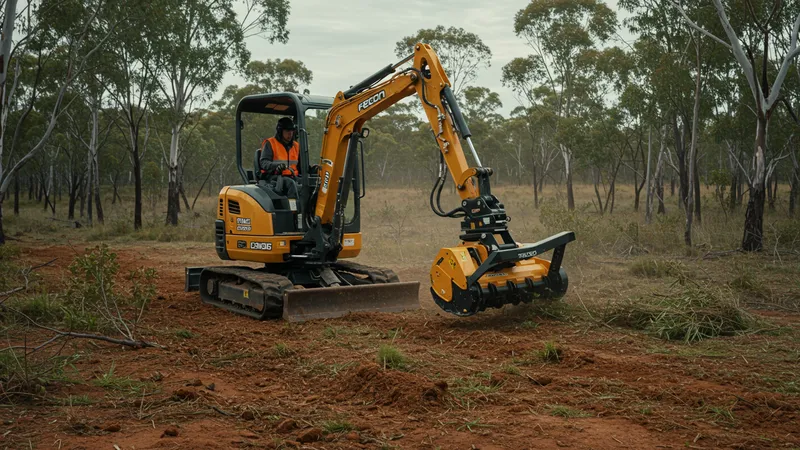
It’s equally important to match hydraulic output between the excavator and attachment. Leading manufacturers provide detailed flow and pressure guides to ensure that units like the FAE BL1/EX run at peak efficiency. Under-powering an attachment not only undermines productivity but also risks mechanical failure—a key concern for operators working in Australia’s remote regions where support may be hours away.
Regular maintenance, including frequent inspections of cutting teeth and bearings, will maximize service life and mulching performance. Australian dust and grit can accelerate wear, so contractors are encouraged to adopt pre-start checklists and core maintenance routines. Onsite spare parts for brands like Mower King reduce unexpected downtime and are vital for multi-week rural contracts.
The future points to continued innovation and uptake of compact mulching options as Australian landcare and construction sectors seek adaptable, eco-conscious solutions. Operators that invest in high-quality, well-matched attachments benefit from more efficient, environmentally sensitive site management—yielding lasting results across the Australian landscape.